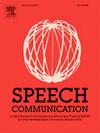Comparisons of Mandarin on-focus expansion and post-focus compression between native speakers and L2 learners: Production and machine learning classification
IF 3
3区 计算机科学
Q2 ACOUSTICS
引用次数: 0
Abstract
Korean and Mandarin are reported to have on-focus expansion and post-focus compression in marking prosodic focus. It is not clear whether Korean L2 learners of Mandarin benefit from this prosodic similarity in the production of focused tones or encounter difficulty due to the interaction between tone and intonation in a tonal language. This study examined the prosodic focus of Korean L2 learners of Mandarin through a production experiment, followed by the development of a machine learning classification to automatically detect learners’ production of focused elements. Learners were divided into two groups according to proficiency level (advanced and intermediate) and were directly compared with Mandarin native speakers. Production results showed that intermediate-level speakers did not show any systemic modulations for focus marking. Although the advanced-level speakers performed better than the intermediate group, their prosodic effects of focus were significantly different from those of native speakers in both focus and post-focus positions. The machine learning classification of focused elements reflected clear focus-cueing differences among the three groups. The accuracy rate was about 86 % for the native speakers, 49 % for the advanced learners, and about 34 % for the intermediate learners. The results of this study suggest that on-focus expansion and post-focus compression are not automatically transferred across languages, even when those languages share similar acoustic correlates of prosodic focus. This study also underscores that the difficulty in acquiring the prosodic structure of a tone language lies mainly in mastering tone acquisition, which impacts non-tonal language learners, leading to ineffective performance of on-focus expansion and post-focus compression.
本族语使用者与二语学习者普通话焦点前扩展与焦点后压缩的比较:生产与机器学习分类
据报道,韩语和普通话在标记韵律焦点时存在焦点前扩展和焦点后压缩的现象。目前尚不清楚,韩国的普通话第二语言学习者是受益于这种韵律上的相似性,还是由于声调语言中声调和语调的相互作用而遇到困难。本研究通过生成实验考察了韩国第二语言汉语学习者的韵律焦点,随后开发了一种机器学习分类,以自动检测学习者产生的焦点元素。学习者根据熟练程度分为两组(高级和中级),并直接与普通话母语者进行比较。生产结果表明,中级水平的讲话者没有表现出任何系统的焦点标记调制。虽然高水平的说话者比中级水平的说话者表现得更好,但他们在焦点位置和后焦点位置上的注意力韵律效果与母语者有显著差异。聚焦元素的机器学习分类反映了三组之间明显的聚焦线索差异。母语者的准确率约为86%,高级学习者为49%,中级学习者约为34%。本研究的结果表明,非焦点扩展和后焦点压缩不会自动跨语言传递,即使这些语言具有相似的韵律焦点声学关联。本研究还强调了声调语言韵律结构习得的困难主要在于掌握声调习得,这影响了非声调语言学习者,导致非焦点扩展和焦点后压缩的效果不佳。
本文章由计算机程序翻译,如有差异,请以英文原文为准。
求助全文
约1分钟内获得全文
求助全文
来源期刊

Speech Communication
工程技术-计算机:跨学科应用
CiteScore
6.80
自引率
6.20%
发文量
94
审稿时长
19.2 weeks
期刊介绍:
Speech Communication is an interdisciplinary journal whose primary objective is to fulfil the need for the rapid dissemination and thorough discussion of basic and applied research results.
The journal''s primary objectives are:
• to present a forum for the advancement of human and human-machine speech communication science;
• to stimulate cross-fertilization between different fields of this domain;
• to contribute towards the rapid and wide diffusion of scientifically sound contributions in this domain.
 求助内容:
求助内容: 应助结果提醒方式:
应助结果提醒方式:


